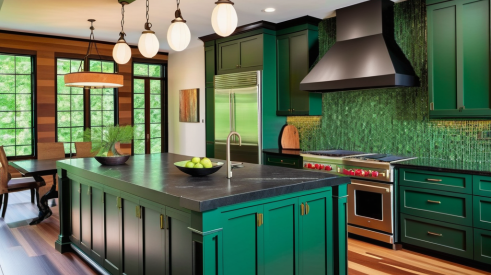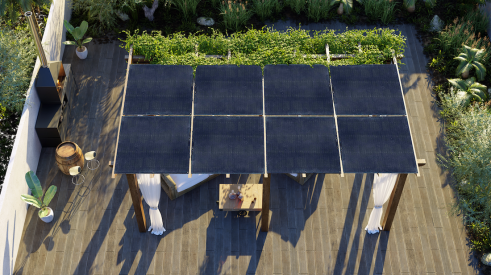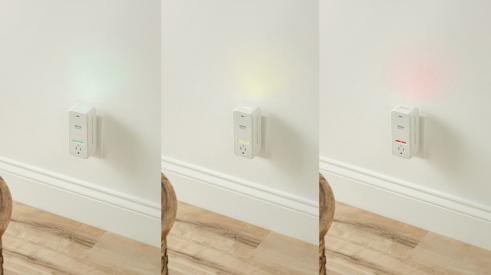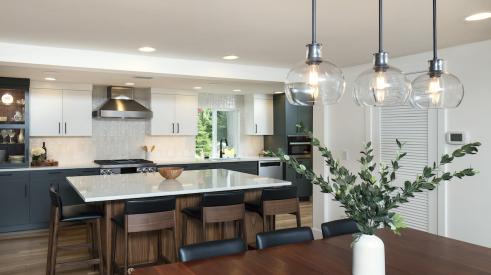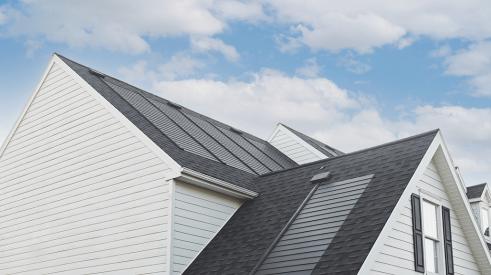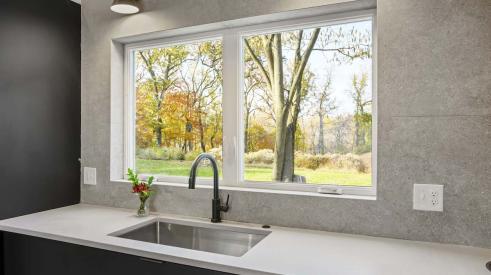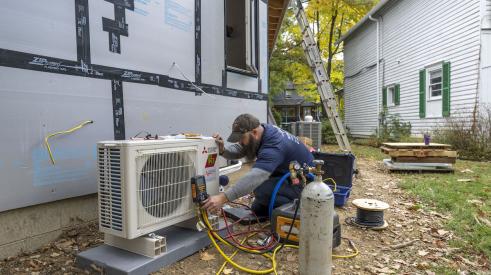As energy prices climb and homeowners remain in their homes longer, making homes more energy efficient is gaining popularity. While DIY homeowners may caulk and seal, remodelers can provide a higher level of energy savings by installing appropriate products. These products may qualify for federal, state and local tax credits and incentives along with LEED points.
Energy efficiency trends
Homeowners want to reduce their electric, heating and cooling bills while increasing their home’s comfort. Beyond the utility savings from energy-related improvements, many energy companies offer homeowner rebates on energy upgrades, notes Kaethe Schuster of Dow Building Solutions.
“Local and regional building standards and incentives in various markets have been updated to encourage environmentally responsible home design and renovation,” says Maria McDonagh-Forde of CertainTeed Roofing.
Robert Struble of PPG Architectural Glass says they are seeing a trend for larger window openings to increase daylighting complemented by high-performance glazings to block solar heat gain.
Selecting the right type of energy efficient windows depends on the home’s location. “Passive, low-e glasses such as PPG’s Sungate 600 glass are more suited to northern climates because they transmit higher levels of solar heat while trapping furnace heat inside the home,” explains Struble.
Solar control, low-e glasses like PPG’s Solarban 60 and Solarban 70XL are better for warm climates because they block heat more effectively than passive low-e glasses while still transmitting high levels of daylight. Both Sungate and Solarban glasses appear transparent, so they can be used with clear glass in insulating glass units to create a clear glass look, or combined with a tinted glass to achieve a lightly tinted aesthetic. PPG is working with window manufacturers to develop R-5 insulating performance by using low-e coatings dual-pane windows to get the benefit of triple pane windows at a lower price point
Roofing solutions
Solar reflective roofing and photovoltaic solar roof panels can contribute to energy efficiency. While these roof technologies provide a greater benefit in warmer climates, they help reduce carbon emissions wherever they are installed.
CertainTeed Landmark Solaris Platinum shingles reflect 40 percent or more of the sun’s infrared rays, resulting in much cooler roof temperatures compared to ordinary asphalt shingles. “By keeping the roof cooler, the solar reflective technology reduces ‘thermal shock,’ the expansion and contraction of the shingles due to temperature variations,” says McDonagh-Forde.
Two choices in the Solaris shingle line offer 25 percent solar reflectivity. Presidential Shake Solaris replicates the look of authentic wood shakes, delivering the charm of hand-split wood shakes with durability and strength.
Landmark Solaris Gold’s rich, dark hues have a lifetime limited warranty. Featuring reflective granules that can reduce a roof’s temperature up to 20 percent, Landmark Solaris IR shingles come in natural colors and earth tones. Engineered with a tough fiberglass scrim for increased durability, they have a lifetime limited transferable warranty.
Photovoltaic solar roofing systems are increasing in popularity. The 2011 U.S. Solar Market Insight report showed solar installations in the United States more than doubled from 2010 to 2011. A recent Institute for Local Self-Reliance study projects 100 million U.S. residents could have solar on their roofs by 2021, says Dan Pezolt of Dow Solar.
Unlike traditional raised solar panels, new technology integrates the panels into the roof itself. CertainTeed’s Apollo Solar Roofing System features highly integrated high performance polycrystalline photovoltaic panels. Apollo is lightweight, durable and resistant to wind uplift.
“Unlike rack-mounted solar systems, Apollo fully integrates with roofing shingles for a clean, seamless appearance,” McDonagh-Forde points out. Each slim, 12-pound module features 14 high-efficiency polycrystalline silicon solar cells that absorb sunlight and convert it into electricity. No structural reinforcement or evaluation is required, making it easier for contractors to install while maintaining roof deck integrity. These solar arrays produce 12 watts of electricity per square foot, more than double the output of some other technologies, so significantly smaller arrays will generate the same amount of power. The Apollo system is offered in pre-engineered kits containing all necessary components.
Homeowners can review and analyze their Apollo system’s performance on any Web-enabled device in real time. The simple interface shows the system’s production in watts and its total historical production, as well as tracking operating trends by the hour, day, week and month. Also displayed are the pounds of carbon dioxide the system has avoided emitting, the trees saved and the gallons of gas it has displaced.
Dow Solar’s integrated photovoltaic product is the roof itself. Dow Powerhouse Solar Shingle is a three-part solar roofing system package including an array of lightweight shingles, an inverter and an energy monitoring system.
“The shingles are custom designed to fit the individual homeowner’s budget and energy goals and arranged to complement the style and form of the home and roofline,” explains Pezolt “They have a ‘flush to the roof’ look and the ability to withstand the rugged construction environment.” The shingles use an interconnected “plug and play” electric system, so the roofing crew does not interface with cords or exposed wiring between shingles. After roof installation is complete, a certified electrician working below the rooftop connects the system to the inverter.
Once connected, the inverter converts direct current produced from the shingles into alternating current fed to the home’s appliances or back to the power grid. A real-time monitoring system accessible from any Internet-enabled device provides readouts allowing homeowners to assess energy usage, production and the amount of power flowing to the grid.
Powerhouse Solar Shingles were designed with diverse conditions in mind. Using Copper Indium Gallium diSelenide-based thin-film photovoltaic cells, the shingles perform well in non-standard conditions such as slight shading, cloudiness and dim light.
Dow Powerhouse Solar Shingles can only be installed by authorized dealers to ensure systems will meet homeowners’ energy needs and maximize the product’s solar functionality. The shingles are installed using standard asphalt roofing materials. No post-installation maintenance is needed.
Insulation and air sealing solutions
Keeping the outside temperature out increases indoor comfort, and drafty homes and high energy bills make this an enticing target for remodelers.
“Improving the overall energy efficiency of the home by sealing gaps and cracks helps protect against moisture and air infiltration, thus reducing the potential for mold and mildew growth and minimizing intrusion of pests, dust and exterior allergens,” says Schuster. “Upgrading walls with a continuous insulation layer also helps moderate the wall cavity temperature, keeping the home cool in the summer and warm in the winter.
“Air leakage through holes, gaps and cracks is the single biggest cause of home heating and cooling loss and actually accounts for 30 to 50 percent of the energy used in most homes,” Schuster stresses. “If you took all the gaps and cracks around window and door frames, electrical outlets, plumbing lines, under the siding, in the basement and in many other places, they’d add up to a space the size of a standard window.” That means unsealed homes function as if a window is open.
Dow Building Solutions offers scientifically based insulation, weatherization and air sealing solutions to help remodelers reduce energy costs and protect against wind, rain and moisture while reducing greenhouse gas emissions. For roof/walls, attics, basements, ducts, rim joists, crawl spaces, windows/doors and beam pockets, Dow’s Froth-Pak Foam Insulation and Froth-Pak Foam Sealant kits are good choices.
“Designed for both insulation and air sealing applications, this two-component, low-pressure polyurethane foam quickly expands to fill cavities and cracks greater than two inches and becomes tack free in seconds,” says Schuster.
Product selection depends on the size and accessibility of the area where air sealing is needed. Froth-Pak is preferred for basement rim joists because this portable foam system and two-component spray product works well in a large area. It also allows re-entry in one hour compared to high pressure drum spray polyurethane foam which requires a longer wait.
Uninsulated foundations, basements and crawl spaces can be retrofitted with Dow’s Thermax Insulation or Thermax Sheathing. These are placed on basement wall interiors to increase energy efficiency and reduce potential for moisture condensation. Available with a foil-faced or white finish, they may be left exposed to the interior to reduce initial remodeling costs and finished later as desired. Styrofoam Brand Extruded Polystyrene (XPS) Foam Insulation can be used on basement wall interiors and can also be extended to the exterior of above-grade walls as continuous insulation to address thermal bridging.
“Owens Corning’s Foamular XPS foam sheathing and Pink Wrap house wrap help insulate and manage moisture outside the home, while our EnergyComplete air sealing and insulating system delivers comfort, energy efficiency and lower monthly heating and cooling costs to homeowners from the inside out,” says Dave Rosebery of Owens Corning. This Complete Energy Performance package includes several varieties of blown-in, loose-fill insulation and the new EcoTouch Insulation available in traditional batt and roll form.
Owens Corning’s Pink latex-based expanding spray foam actually forms a flexible seal with the house framing. “Unlike caulk and other air sealants, it stays flexible for the life of the home to help keep it comfortable and energy efficient,” Rosebery says. Homeowners get the added benefit of reducing allergens, moisture and pests.
The payoff
Payback time for energy efficiency improvements decreases every time energy costs rise. Savings from low-e windows depend on location. As an example, Struble cites research done by the Texas Window Initiative estimating a reduction in Texans’ home energy use of 2.7 to 9.5 kilowatt hours per year for each square foot of window glass. If a kilowatt hour costs 15 cents, annual savings range from $90 to $320 for a house with 225 square feet of windows. Studies done on commercial buildings with low-e glass show energy use reductions of 15 to 20 percent.
“Adding insulation is still one of the best home improvement investments a homeowner can make,” Rosebery points out. “Not only do insulating projects make homes more comfortable, but DOE studies show that homeowners can reduce their heating and cooling bills by up to 20 percent per year by properly air sealing and insulating their homes.” Savings start immediately and continue through the life of the home.
Dow’s calculations show that air sealing the basement rim joist with Froth-Pak can save homeowners $125 annually. Payback takes less than three months with an ROI of 600 percent. A Powerhouse Solar roof system typically offsets 40 to 60 percent of a home’s electricity costs.
The days of cheap energy are over. Consumers are motivated to cut their energy costs and are willing to invest in home improvements to do so.
Finding modest investments that can bring repeat savings for homeowners
Add new comment
Related Stories
Working Toward Affordable, Resilient Homes
A new natural disaster protection act from NAHB aims to support hazard mitigation projects
Client Design Choices in the Time of Social Media and AI
Social media speeds up the trend cycles, and now artificially created images are falling into homeowners' hands
Indoor Air Quality Gets Smart
A home's air quality can now be cloud connected and fully automated with this innovative product
Webinar: From Disjointed Design to Cohesive and Efficient—The New American Remodel 2023
Access the recording for the first The New American Remodel webinar held on March 8 at 2 pm CT
5 Standout Energy-Efficient Products Spotted at IBS 2023
See what this green remodeler recommends from the show floor
Innovative Products: GAF Energy Timberline Solar Shingles
GAF Energy’s latest innovation has taken the solar world by storm
Detailed Design: Benefits of Biophilism
See the details our Model ReModel contractors chose to infuse nature into their ADU
Heat Pumps Now Required in Washington New Construction
Washington is the second state to require heat pumps in an effort to electrify homes





